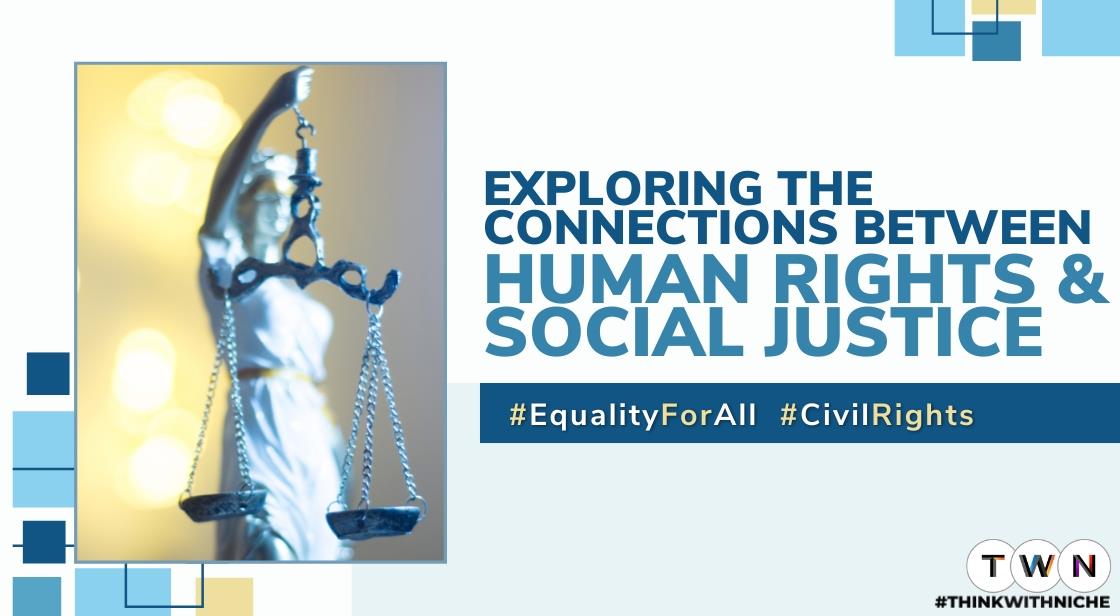Exploring the Connections Between Human Rights and Social Justice

Blog Post
The intricate relationship between human rights and social justice forms the backbone of many contemporary societal discussions and policy-making endeavors. Human rights, defined as the fundamental entitlements inherent to all individuals regardless of nationality, sex, ethnicity, religion, or any other status, are essential for ensuring dignity and equality.
These rights encompass a wide spectrum, including civil, political, economic, social, and cultural rights. On the other hand, social justice pertains to the fair and just distribution of resources, opportunities, and privileges within a society, aiming to eliminate disparities and foster inclusivity.
The connection between human rights and social justice is both profound and multifaceted. At its core, the pursuit of social justice seeks to actualize human rights for all individuals, ensuring that no one is marginalized or deprived of their basic entitlements.
This interconnection underscores the necessity of addressing systemic inequalities and institutional biases that hinder the realization of human rights. For instance, issues such as poverty, discrimination, and lack of access to education and healthcare are not only social justice concerns but also significant human rights challenges.
Moreover, the global landscape of human rights and social justice is continually evolving, influenced by movements advocating for gender equality, racial justice, LGBTQ+ rights, and environmental justice, among others.
These movements highlight the imperative to adopt an intersectional approach, recognizing that various forms of oppression are interconnected and must be tackled collectively.
In essence, exploring the connections between human rights and social justice reveals the critical need for integrated efforts to build a more equitable and humane world. It emphasizes that achieving true social justice is inherently tied to the unwavering protection and promotion of human rights for every individual.
The Relationship Between Human Rights and Social Justice
In today's globalized world, the concepts of human rights and social justice are more crucial than ever. They serve as guiding principles in addressing pressing issues such as poverty, inequality, discrimination, and environmental degradation. Upholding human rights ensures that individuals can live with dignity and freedom, while advancing social justice fosters a society where everyone has access to equal opportunities and fair treatment.
1. Definition and Context of Human Rights and Social Justice
Human rights and social justice are interconnected concepts that aim to promote dignity, equality, and fairness for all individuals. While human rights focus on fundamental freedoms and protections, social justice addresses systemic inequalities and strives for a more just and equitable society. Both concepts continue to evolve through legal frameworks, activism, and societal changes to ensure the well-being and rights of all people are upheld.
Human Rights: Human rights refer to the basic rights and freedoms that every person is entitled to, regardless of nationality, ethnicity, religion, gender, or other status. These rights are inherent to all human beings and are often codified in national laws, international treaties, and customary international law. They encompass civil, political, economic, social, and cultural rights, such as the right to life, liberty, equality, and dignity.
Social Justice: Social justice pertains to the fair and equitable distribution of resources, opportunities, and privileges within a society. It aims to ensure that all individuals have equal access to wealth, health, well-being, justice, and rights. Social justice seeks to rectify systemic injustices, discrimination, and inequalities based on factors like race, class, gender, and sexual orientation.
Origins and Evolution of Human Rights and Social Justice
Origins of Human Rights
The concept of human rights has ancient roots in various cultures and philosophies but gained modern prominence following World War II with the adoption of the Universal Declaration of Human Rights (UDHR) in 1948. This pivotal document, drafted by representatives from diverse legal and cultural backgrounds, laid the groundwork for a common understanding of fundamental rights and freedoms to be universally protected.
Ancient and Philosophical Foundations:
-
Ancient Civilizations: Early notions of human rights can be traced back to ancient civilizations such as Babylon, where the Code of Hammurabi established laws that included rights for individuals, and Ancient Greece and Rome, where philosophers like Socrates, Plato, and Cicero discussed the principles of natural law and justice.
-
Religious Texts: Religious teachings across Judaism, Christianity, Islam, Buddhism, and Hinduism also provided foundational concepts of human dignity, justice, and moral conduct.
Enlightenment and Early Modern Developments:
-
Magna Carta (1215): This English charter established the principle that everyone, including the king, was subject to the law and provided for certain rights of individuals.
-
Enlightenment Era: Philosophers like John Locke, Jean-Jacques Rousseau, and Montesquieu further developed the idea of natural rights, emphasizing life, liberty, and property.
-
American and French Revolutions: The American Declaration of Independence (1776) and the French Declaration of the Rights of Man and of the Citizen (1789) were instrumental in asserting the idea of inalienable rights.
Post-World War II and Modern Developments:
-
Universal Declaration of Human Rights (1948): Adopted by the United Nations General Assembly, the UDHR established a comprehensive set of rights that all human beings are entitled to, regardless of nationality, ethnicity, religion, or gender.
-
International Treaties: The UDHR paved the way for legally binding treaties such as the International Covenant on Civil and Political Rights (1966) and the International Covenant on Economic, Social and Cultural Rights (1966), collectively known as the International Bill of Human Rights.
-
Regional Human Rights Systems: Various regions developed their own human rights instruments, such as the European Convention on Human Rights (1950), the American Convention on Human Rights (1969), and the African Charter on Human and Peoples' Rights (1981).
Recent Developments:
-
United Nations Agenda 2030: The Sustainable Development Goals (SDGs), adopted in 2015, emphasize human rights as integral to achieving sustainable development, focusing on eliminating poverty, reducing inequalities, and promoting peace and justice.
-
Technological Impact: The rise of digital technologies has brought new challenges and opportunities for human rights, including issues related to privacy, freedom of expression, and access to information.
Origins of Social Justice
Social justice has deep historical roots in movements for equality and fairness, encompassing various dimensions of economic, social, and political life. It aims to address systemic injustices and promote an equitable distribution of resources and opportunities.
Early and Philosophical Foundations:
-
Religious Teachings: Early ideas of social justice are present in religious teachings that advocate for fairness, charity, and compassion. For example, the teachings of the Hebrew prophets, Jesus Christ, and the Islamic principles of Zakat emphasize helping the poor and marginalized.
-
Philosophical Contributions: Philosophers such as Aristotle discussed the idea of distributive justice, which focuses on the fair allocation of resources in society.
Also Read: Understanding the Urgency of Global Food Security in 2024: Beyond Availability to Sustainability
Key Principles and Values of Human Rights and Social Justice:
Human Rights: Key principles include universality (applicable to all individuals), inalienability (cannot be taken away), indivisibility (all rights are interconnected), and accountability (states and other actors are responsible for upholding rights). Values associated with human rights include dignity, equality, justice, and freedom.
Social Justice: Key principles include equity (fair distribution of resources), solidarity (support for marginalized groups), participation (involvement of all stakeholders in decision-making), and diversity (respect for differences). Values associated with social justice include fairness, inclusivity, empowerment, and community.
2. Common Principles and Goals of Human rights and social justice
Human rights and social justice share fundamental principles aimed at promoting fairness, equality, and dignity for all individuals. Both frameworks emphasize the inherent worth and rights of every person, advocating for their protection and fulfillment in society.
Fairness and Equality
Human Rights: The Universal Declaration of Human Rights (UDHR), adopted by the UN in 1948, asserts the right to equal protection under the law and non-discrimination based on race, gender, or other characteristics.
Social Justice: Focuses on addressing systemic inequalities that hinder equal opportunities, such as disparities in education, healthcare access, and economic opportunities.
Dignity and Respect
Human Rights: Central to human rights is the concept of human dignity, which underpins the right to live free from torture, slavery, or degrading treatment.
Social Justice: Upholds the dignity of individuals by advocating for policies and practices that empower marginalized communities and protect their rights.
Overlapping Goals
Both human rights and social justice seek to create inclusive societies where every individual can flourish without facing prejudice or barriers. They strive to:
-
Combat Discrimination: Addressing discriminatory practices and promoting inclusive policies (e.g., anti-discrimination laws and affirmative action programs).
-
Ensure Access to Basic Needs: Guaranteeing access to essential services such as healthcare, education, and housing, regardless of socioeconomic status.
Examples and Case Studies
-
Marriage Equality: The movement for marriage equality exemplifies the intersection of human rights and social justice. Advocates argued both for the human right to marry the person of one's choice (regardless of gender) and for social justice in recognizing and respecting diverse forms of families.
-
Black Lives Matter Movement: Originating in the United States, this movement highlights systemic racism and advocates for social justice reforms to ensure equal treatment and dignity for Black individuals, aligning with principles of human rights against discrimination and injustice.
3. Human Rights Framework
Introduction to Human Rights Framework
The human rights framework provides a comprehensive set of principles and standards aimed at ensuring the inherent dignity and equality of all individuals globally. These frameworks are enshrined in international law and serve as the basis for promoting social justice and equity across nations.
Major Human Rights Documents
-
Universal Declaration of Human Rights (UDHR): Adopted by the United Nations General Assembly in 1948, the UDHR outlines fundamental human rights that are universally applicable. It includes rights such as the right to life, liberty, and security, freedom from torture and slavery, and the right to education and work.
-
International Covenant on Civil and Political Rights (ICCPR): This treaty, along with its Optional Protocols, safeguards civil and political rights, including the right to self-determination, freedom of speech, religion, and assembly. It establishes mechanisms for individuals to seek redress if their rights are violated.
Promoting Social Justice Globally
These frameworks promote social justice globally through several key mechanisms:
-
Legal Standards: By establishing legally binding norms, human rights frameworks provide a basis for holding governments and other actors accountable for upholding human dignity and equality.
-
Advocacy and Awareness: They serve as powerful advocacy tools, empowering civil society organizations and individuals to raise awareness about rights violations and advocate for change.
-
International Cooperation: Human rights frameworks foster international cooperation and dialogue, encouraging states to work together to address global challenges such as poverty, discrimination, and conflict.
-
Education and Empowerment: They promote education about rights and responsibilities, empowering individuals to claim their rights and participate actively in their societies.
Challenges and Criticisms
Despite their significance, human rights frameworks face challenges such as enforcement gaps, cultural relativism, and the prioritization of state sovereignty over individual rights in some contexts. Critics argue that these frameworks sometimes fail to address economic and social inequalities adequately.
4. Social Justice Movements
Historical Social Justice Movements
Social justice movements have a long history of advocating for human rights. One of the most significant historical movements is the Civil Rights Movement in the United States during the 1950s and 1960s. Led by figures like Martin Luther King Jr., this movement fought against racial segregation and discrimination, leading to landmark legislation such as the Civil Rights Act of 1964 and the Voting Rights Act of 1965. These laws dismantled institutional racial barriers, promoting equal rights and justice for African Americans.
Contemporary Social Justice Movements
In contemporary times, movements like Black Lives Matter (BLM) have gained prominence. BLM emerged in response to police brutality and systemic racism, advocating for the protection and affirmation of Black lives. The movement has raised global awareness about racial injustices and has influenced policy changes and police reforms in various cities and states.
Advocacy for Human Rights Realization
These movements advocate for human rights through various means, including peaceful protests, policy advocacy, and public education. They aim to dismantle systemic inequalities and promote equality and justice. For example, the feminist movement has continually worked towards gender equality, advocating for rights such as equal pay, reproductive rights, and protection against gender-based violence.
Successful Social Justice Initiatives
Numerous initiatives have successfully promoted human rights. The #MeToo movement, for example, has brought global attention to sexual harassment and assault, leading to significant changes in workplace policies and increased accountability for perpetrators. Another example is the LGBTQ+ rights movement, which has achieved major milestones like the legalization of same-sex marriage in many countries, ensuring greater equality and recognition of LGBTQ+ individuals.
Through persistent advocacy and activism, social justice movements have played a crucial role in advancing human rights and fostering a more equitable society.
5. Challenges in Achieving Human Rights and Social Justice
Achieving human rights and social justice is fraught with challenges stemming from systemic discrimination, lack of political will, and economic disparities. Discriminatory laws and policies, cultural biases, and historical injustices create barriers to equality and fairness. Moreover, entrenched power dynamics often perpetuate inequalities, making it difficult to ensure that all individuals enjoy their fundamental rights.
Intersectionality: Impact of Race, Gender, and Socioeconomic Status to both human rights and social justice
Intersectionality highlights how various aspects of identity—such as race, gender, sexual orientation, and socioeconomic status—intersect and compound to shape individuals' experiences of discrimination and access to rights. For example, women of color or LGBTQ+ individuals from lower socioeconomic backgrounds often face compounded marginalization. Intersectionality underscores the need for policies and interventions that recognize and address these complex interactions to achieve meaningful social justice.
Global Inequalities and Disparities
Globally, inequalities and disparities further hinder progress towards human rights and social justice. Developing countries may struggle with poverty, lack of access to education and healthcare, and weak governance, amplifying vulnerabilities and denying basic rights to many. Wealthier nations, while often having more robust legal frameworks, may still face challenges in addressing systemic racism, gender inequality, and economic disparities within their borders.
Systemic Barriers to Progress
Systemic barriers, rooted in historical injustices and unequal power dynamics, impede efforts to advance human rights and social justice universally. These barriers manifest in policies that perpetuate discrimination, unequal distribution of resources, and limited access to justice systems for marginalized groups. Overcoming these barriers requires comprehensive strategies that address both immediate needs and underlying structural inequalities.
Pathways Forward: Advocacy and Collaboration
Advancing human rights and social justice demands advocacy, grassroots mobilization, and collaboration across sectors and borders. Civil society plays a crucial role in holding governments and institutions accountable, while international cooperation fosters solidarity and support for marginalized communities worldwide. By promoting inclusive policies, investing in education and healthcare, and ensuring equitable economic opportunities, societies can begin to dismantle barriers and foster a more just and equitable world.
6. Practical Applications and Advocacy
Promoting human rights and social justice requires concerted efforts across various domains, from grassroots activism to policy-making and education. Here’s an overview of practical applications and advocacy strategies:
Education
Education plays a pivotal role in promoting human rights and social justice by raising awareness and fostering empathy. Schools and universities can integrate human rights education into their curricula, teaching students about universal rights, historical injustices, and contemporary issues. This empowers future generations to become advocates for change and cultivates a culture that values diversity and equality.
Policy-Making
Policy-Making Effective policy-making is essential for enshrining human rights protections into law and ensuring accountability. Advocacy organizations and concerned individuals can engage in policy advocacy by lobbying lawmakers, drafting policy proposals, and participating in public consultations. Through these efforts, they can influence legislation that addresses systemic inequalities and protects marginalized communities.
Lobbying Lawmakers: Advocacy organizations can engage in policy advocacy by lobbying lawmakers. For example, Human Rights Watch frequently lobbies for legislative changes to prevent human rights abuses worldwide.
Drafting Policy Proposals: Drafting policy proposals is another crucial strategy. The American Civil Liberties Union (ACLU) often drafts detailed proposals to reform the criminal justice system, aiming to reduce racial disparities and protect civil liberties.
Participating in Public Consultations: Participation in public consultations allows individuals and groups to voice their concerns. For example, indigenous communities in Canada have participated in consultations to influence policies regarding land rights and environmental protections.
Grassroots Activism
Grassroots activism mobilizes communities to advocate for change from the ground up. It involves organizing protests, petitions, community meetings, and direct actions to raise awareness, challenge injustice, and pressure decision-makers. Grassroots movements often amplify marginalized voices and hold institutions accountable, driving social change through collective action and solidarity.
Advocacy Efforts
Advocacy efforts bridge the gap between theory and practice by translating principles of human rights and social justice into tangible actions. Advocates utilize various strategies such as media campaigns, legal challenges, and coalition-building to amplify their message and mobilize support. By engaging diverse stakeholders and forming alliances, advocates can leverage collective strength to influence public opinion and policy decisions.
Role of Technology
Technology provides new avenues for advocacy and education, enabling activists to reach global audiences, document human rights abuses, and coordinate responses in real-time. Social media platforms, online petitions, and digital storytelling empower individuals to share experiences and mobilize support across borders, facilitating international solidarity and awareness.
7. Case Studies and Examples: Human Rights Advancing Social Justice
These diverse case studies illustrate the interconnectedness of human rights and social justice, showcasing how efforts in one domain can significantly impact the other.
Civil Rights Movement in the United States:
The Civil Rights Movement of the 1950s and 1960s in the United States is a seminal example of human rights advocacy advancing social justice. Led by figures such as Martin Luther King Jr., the movement sought to end racial segregation and discrimination against African Americans. The successful passage of the Civil Rights Act of 1964 and the Voting Rights Act of 1965 marked significant strides in ensuring equal rights and addressing systemic inequalities, profoundly impacting American society.
South Africa's Anti-Apartheid Struggle In South Africa:
The anti-apartheid movement led by Nelson Mandela and the African National Congress (ANC) exemplifies the fight for human rights contributing to social justice. The movement's efforts culminated in the end of apartheid in 1994 and the establishment of a democratic government. The subsequent policies focused on reconciliation, equality, and social justice, transforming South African society and promoting human dignity.
Land Rights in Brazil:
The struggle for indigenous land rights in Brazil highlights how human rights advocacy can advance social justice. Indigenous groups, with the support of organizations like Survival International, have fought for the recognition of their ancestral lands. Legal victories, such as the demarcation of indigenous territories, have not only protected cultural rights but also promoted environmental conservation and social equity.
Gender Equality in Scandinavia:
Scandinavian countries, such as Sweden and Norway, provide examples where the pursuit of social justice has advanced human rights. These nations have implemented comprehensive policies promoting gender equality, such as parental leave and equal pay initiatives. These measures have significantly improved women's rights and contributed to a more equitable society.
LGBTQ+ Rights in Taiwan Taiwan's:
legalization of same-sex marriage in 2019 is a landmark case where advancing human rights has promoted social justice. The decision came after years of advocacy by LGBTQ+ groups, leading to greater acceptance and equality for the community within Taiwanese society.
Conclusion
Integrating human rights and social justice is essential for addressing global challenges. By understanding their interconnectedness, promoting education, and advocating for inclusive policies, societies can foster equality, dignity, and fairness for all, building a just and equitable world.
You May Like
EDITOR’S CHOICE












